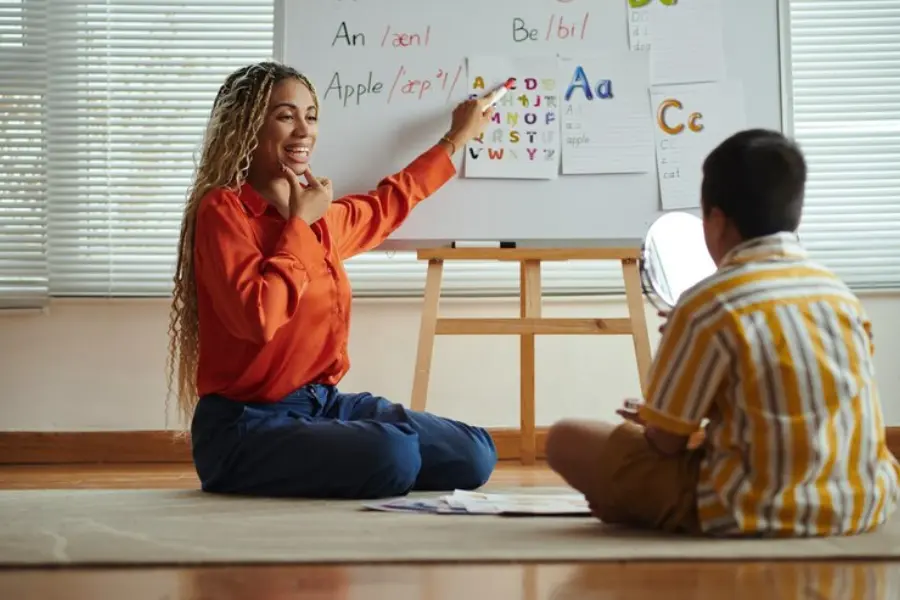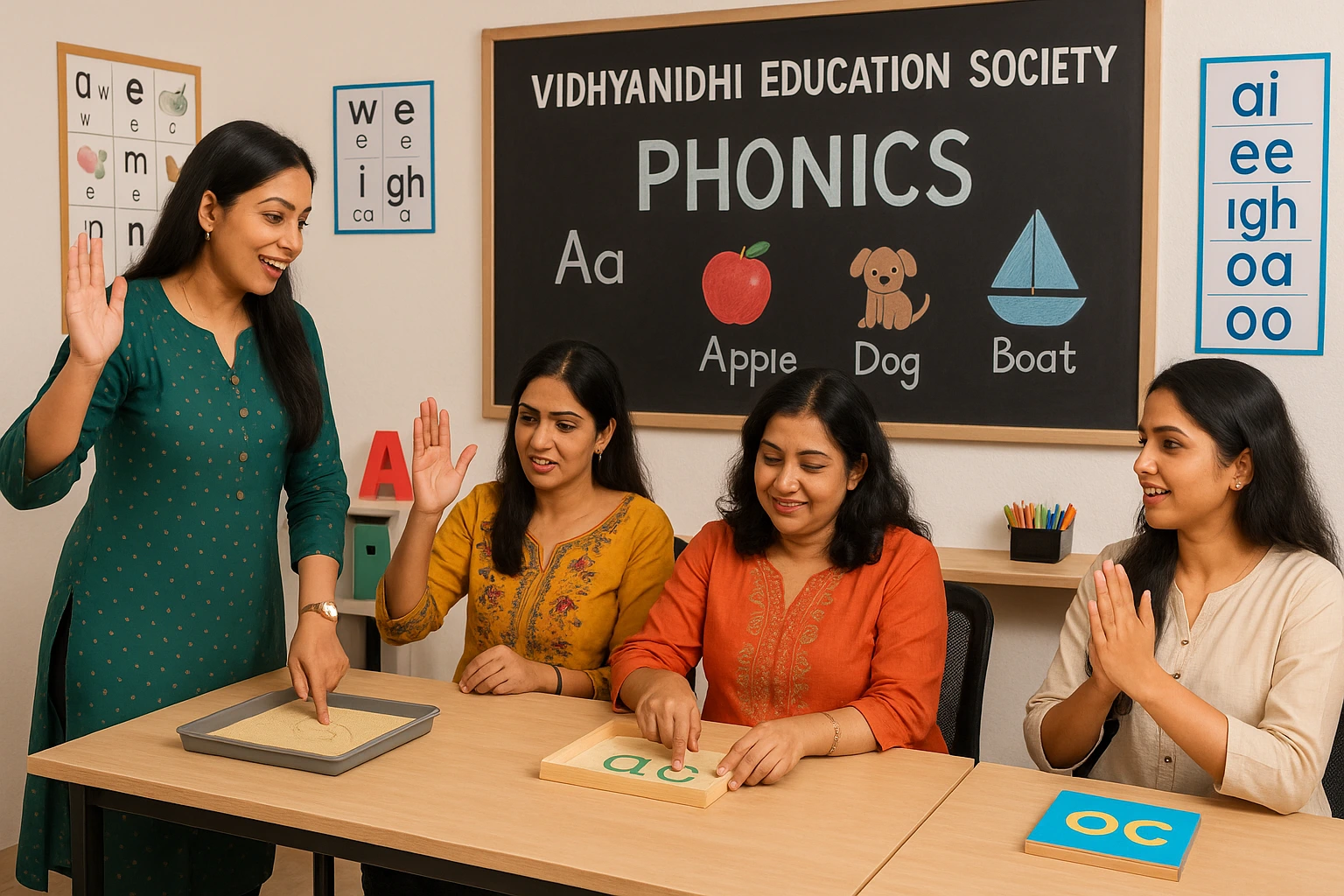
Source: freepik
Phonics forms the basis of early reading skills, making it necessary for teachers to focus on practical methods of instruction. Teaching Phonics Training trains educators with the fitting tools to help children interpret words, identify patterns, and build robust literacy skills from the beginning. In present-day classrooms, where reading difficulties are increasingly common, Teaching Phonics Training plays a vital role in shaping confident and competent readers.
Why Schools are Prioritizing Phonics-Trained Teachers?
In early education, robust reading aptitudes are the basis for academic success. Schools have acknowledged the crucial role Phonics Plays in literacy expansion and are increasingly seeking teachers who are particularly trained in phonics pedagogy.
To Download Brochure about Phonics Teacher Course, Click Here!
For more details of Phonics Teacher Course Call / Whatsapp +919869866277 / +919869546913
Here’s Why Schools are Prioritizing Phonics-Trained Teachers:
Strong Literacy Outcomes
Phonics promotes early reading fluency by familiarizing letter-sound associations, helping students interpret words with ease. Students acquainted with integrated phonics programs often perform better in reading assessments. Early success in reading leads to higher confidence and better academic performance across subjects.
Consistency in Teaching Methods
Phonics-trained teachers follow systematic, research-based approaches that ensure consistency in instruction. Standardized teaching methods reduce confusion and support students at different learning levels.
Addressing Learning Gaps Early
Phonics instruction is particularly beneficial for children with reading delays or speech processing issues. Teaching Phonics Training helps teachers recognize early signs of reading difficulties and adjust their techniques accordingly.
Meeting Curriculum Standards
Educational boards and literacy structures highlight phonics as a fundamental element of early literacy. Schools prefer educators with phonics teaching certification to align their pedagogy practices with international norms.
Building a Robust Foundation
Proficiency in phonics helps students acquire better spelling, writing, and comprehension aptitudes. A phonics-inspired method boosts independent reading from early years.
Schools Prioritizing Phonics-Trained Teachers reflects a clear shift toward evidence-based teaching. By prioritizing such educators, schools are supporting long-term literacy success and molding up students for more promising tomorrows.
Phonics Training and Its Impact on Student Engagement
Teaching Phonics Training plays a key role in shaping how students experience reading in the classroom. When teachers are trained with effective phonics instruction skills, they design learning conditions that are interactive, delightful, and highly interesting.
Let us have a look at Phonics Training and Its Impact on Student Engagement:
Active Learning through Sounds
Phonics helps students associate letters with sounds vibrantly and methodically. Activities like sound matching, rhyming games, and blending exercises keep students attentive and engaged.
Boosting Confidence through Decoding
When students can decode words independently, they read with more confidence. This confidence encourages them to participate more actively during reading time.
Interactive Sessions by Professional Teachers
Professionally trained teachers use jingles, flashcards, movement-based activities, and storytelling to make phonics lessons exciting, maintain students’ engagement, and promote hands-on learning.
Consistent Motivation
Phonics lessons with varied, age-appropriate content reduce boredom and repetition. Children stay interested as they see progress in their reading skills.
Promoting Teamwork
Group phonics tasks like phoneme sorting games and sound quests promote teamwork and cooperation. Students learn by observing and engaging with their peers, boosting classroom energy and involvement.
Optimistic Teacher-Student Connection
Teaching Phonics Training makes teachers more responsive to student needs and can modify their techniques smoothly. This adaptability achieved through the Phonics Training creates a classroom where students feel supported and excited to learn.
Phonics Training empowers teachers to guide reading sessions that are far from monotonous. Through vibrant, skill-based instruction, students stay motivated, participate fully, and build a genuine interest in reading from the very beginning.
This is Why Every Teacher Should Prioritize Teaching Phonics Training Today!

Effective Techniques Covered in Phonics Training
Teaching Phonics Training equips educators with distinguishing strategies to support early literacy expansion. These strategies help children acknowledge sound patterns, interpret unknown words, and expand reading fluency. Phonics Training programs are designed to ensure teachers can offer phonics lessons with clarity, structure, and engagement.
Below are the Effective Techniques Covered in Phonics Training for Teachers:
Blending
- Teachers learn to help students merge individual sounds to form words.
- Blending improves reading fluency and aids in word recognition.
- Activities often include oral sound blending and reading decodable words.
Segmenting
- Segmenting teaches students to split words down into respective sounds.
- It builds a robust foundation for both spelling and phonemic understanding.
- Teachers use sound boxes and tapping methods to make this process clear.
Sound-Symbol Association
- Educators are prepared to link each sound with its written symbol.
- This technique is essential for reading and spelling precision.
- Visual resources like letter cards and word walls help fortify this skill.
Multisensory Strategies
- Teaching Phonics Training program emphasizes using multiple senses—sight, sound, touch, and motion—to reinforce understanding.
- Examples include tracing letters in sand, clapping syllables, or using body movements for sounds.
- These techniques keep students interested and enhance memory retention.
Controlled Vocabulary Practice
- Teachers use strategically chosen word lists that go along with the sounds to be introduced.
- Reading practice is gradually increased in complexity to build confidence and fluency.
Structured Lesson Planning
- Teaching Phonics Training includes how to sequence lessons effectively—from introducing new sounds to reviewing old ones.
- Teachers also learn to evaluate student advancement and adapt pedagogy accordingly.
Phonics Training ensures teachers are well-trained to use established methods that support early readers. These effective techniques make literacy instruction more immersed, interactive, and impactful from the beginning.

Transform Your Teaching—Start Quality Phonics Training
Strong reading instruction begins with effective phonics approaches. For teachers aiming to create lasting literacy skills in young learners, structured Teaching Phonics Training is a must. Programs like those presented by Vidhyanidhi Education Society (Govt. Regd.) provide valuable, hands-on methods that can transform classroom teaching.
Here’s how Phonics Training for Teacher programs can make a measurable difference:
Develop Core Literacy Instruction Skills
- Phonics Training for Teachers builds proficiency to teach sound-letter associations clearly.
- Teachers gain skills to support decoding, spelling, and word recognition in young readers.
Involve Students Through Interactive Approaches
- Phonics Training for Teachers includes multisensory means such as jingles, flashcards, activities, and games.
- These methods increase student interest and reinforce learning through active participation.
Learn Blending and Segmenting Strategies
- Educators are taught how to guide students in blending sounds to form words and segmenting words into individual sounds.
- These foundational skills improve reading fluency and spelling accuracy.
Practical Lesson Planning and Delivery
- Phonics Training for Teachers Courses by Vidhyanidhi Education Society (Govt. Regd.) train teachers to design phonics sessions with clear objectives and engaging materials.
- Teachers also learn to assess progress and address varied learning needs effectively.
Boost Confidence in Literacy Instruction
- With Phonics Training for Teachers, educators achieve clarity, confidence, and consistency in their phonics instruction.
- Well-trained teachers make reading delightful and accessible for every student.
By enrolling in a Phonics Training for Teacher course from Vidhyanidhi Education Society (Govt. Regd.), educators can upgrade their teaching approach and build stronger, more confident readers. Transform Your Teaching—Start Quality Phonics Training!
Join the Phonics Teacher Course from Vidhyanidhi Education Society today!
To Download Brochure about Phonics Teacher Course, Click Here!
For more details of Phonics Teacher Course Call / Whatsapp +919869866277 / +919869546913
FAQs
Are phonics-trained teachers more effective in classrooms?
Yes, they create engaging reading sessions and use proven techniques like blending and segmentation to boost literacy.
Where can I enroll for a structured phonics training course?
Institutions like Vidhyanidhi Education Society offer certified phonics training with practical classroom strategies.
What are the benefits of taking a phonics training course?
It enhances teaching skills, boosts student results, and opens career opportunities in early literacy education.



